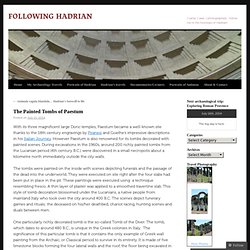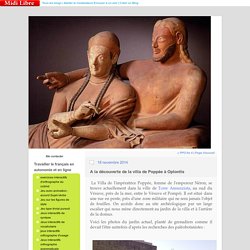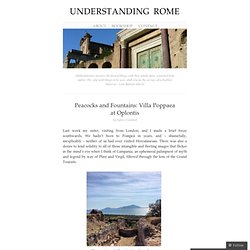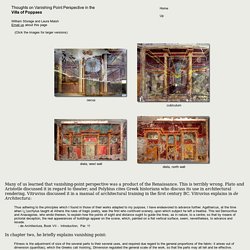

Déesse Fortuna, MAN de Naples. Lar familiaris tenant un rhyton à droite et une patère à gauche. Détail. MAN de Naples. Rome101 home. Visita gli scavi - Soprintendenza Speciale per i Beni Archeologici di Pompei, Ercolano e Stabia. Campania (September 2008) - un album sur Flickr. 2011 – février : Campanie 2011, Les mystères de Pompéi. – Cette année, le projet de voyage des latinistes du Diois les emmène à la découverte de tous les grands sites archéologiques de la Campanie. – Au programme : Pompéi, Herculanum, Stabies, Oplontis, Paestum, Boscoreale, Pouzzoles, Cumes, les champs phlégréens, le Vésuve, la Solfatare, Baïes, le musée archéologique de Naples… – Consulter le projet pédagogique, le Cahier de voyage les documents préparatoires au format pdf et images ci-dessous. – Des nouvelles du voyage seront postées régulièrement sur cette page à partir du dimanche soir, date d’arrivée à l’hôtel.
Jpg_MANN-2.jpg (JPEG Image, 2237 × 1745 pixels) - Scaled (45%) Bacchus et le Vésuve, fresque de Pompéi, Ier siècle, MAN de Naples. The Painted Tombs of Paestum. With its three magnificent large Doric temples, Paestum became a well-known site thanks to the 18th century engravings by Piranesi and Goethe’s impressive descriptions in his Italian Journey.

However Paestum is also renowned for its tombs decorated with painted scenes. During excavations in the 1960s, around 200 richly painted tombs from the Lucanian period (4th century B.C.) were discovered in a small necropolis about a kilometre north immediately outside the city walls. The tombs were painted on the inside with scenes depicting funerals and the passage of the dead into the underworld. They were executed on site right after the four slabs had been put in place in the pit. These paintings were executed using a technique resembling fresco. One particularly richly decorated tomb is the so-called Tomb of the Diver.
Here is a series of images from the Paestum Archaeological Museum collection of paintings, starting with some pictures of the Tomb of the Diver. Like this: A la découverte de la villa de Poppée à Oplontis. La Villa de l'impératrice Poppée, femme de l'empereur Néron, se trouve actuellement dans la ville de Torre Annunziata, au sud du Vésuve, près de la mer, entre le Vésuve et Pompéi.

Il est situé dans une rue en pente, près d'une zone militaire qui ne sera jamais l'objet de fouilles. On accède donc au site archéologique par un large escalier qui nous mène directement au jardin de la villa et à l'arrière de la domus. Voici les photos du jardin actuel, planté de grenadiers comme il devait l'être autrefois d'après les recherches des paléobotanistes : The Oplontis Project. Plan de la villa de Poppée à Oplontis (Campanie)
Peacocks and Fountains: Villa Poppaea at Oplontis. Last week my sister, visiting from London, and I made a brief foray southwards.

We hadn’t been to Pompeii in years, and – shamefully, inexplicably – neither of us had ever visited Herculaneum. There was also a desire to lend solidity to all of those intangible and fleeting images that flicker in the mind’s eye when I think of Campania; an ephemeral palimpsest of myth and legend by way of Pliny and Virgil, filtered through the lens of the Grand Tourists. The view from the Temple of Apollo at Cumae Whilst I’ve been to the glorious Amalfi coast countless times, both from land and sea, the bay of Baiae where Hadrian expired and the Phlegrean Fields where Aeneas consulted the Sybil had proved ever elusive. So this time our journey took us to fabulous Pompeii and Herculaneum, but we also said hello to the Sybil at Cumae and stopped by the entrance to Hades at Lake Avernus.
Villa Poppaea, Torre Annunziata “We lunched at Torre Annunziata at a table on the beach. Villa Poppaea. The Villa Poppaea is an ancient Roman seaside villa (villa maritima) situated between Naples and Sorrento, in southern Italy.

It is also referred to as the Villa Oplontis, or more precisely as Villa A by modern archaeologists. The villa itself is a large structure situated in the ancient Roman town of Oplontis (the modern Torre Annunziata), about ten meters below the modern ground level. Evidence suggests that it was owned by the Emperor Nero, and believed to have been used by his second and rather notorious wife, Poppaea Sabina, as her main residence when she was not in Rome. House Plan & Construction[edit] According to John R.
Guida_Fra.pdf. Oplontis : la villa de Poppée photo © Patricia Carles. Villa of Poppaea, Bedroom. Many of us learned that vanishing-point perspective was a product of the Renaissance.

This is terribly wrong. Plato and Aristotle discussed it in regard to theater; and Polybius cites Greek historians who discuss its use in architectural rendering. Vitruvius discussed it in a manual of architectural training in the first century BC. Vitruvius explains in de Architectura: In chapter two, he briefly explains vanishing point: That the ancients were capable of executing single point perspective is acknowledged by many art historians and archaeologists, and is obvious from a number of extant paintings, including the oecus in the Villa of Poppaea. We added construction lines to four of the paintings from Oplontis. The scheme used in the bedroom (cubiculum, room 11) seems straightforward, considering the small size of the room .
Villa of Poppaea - rome101.com.